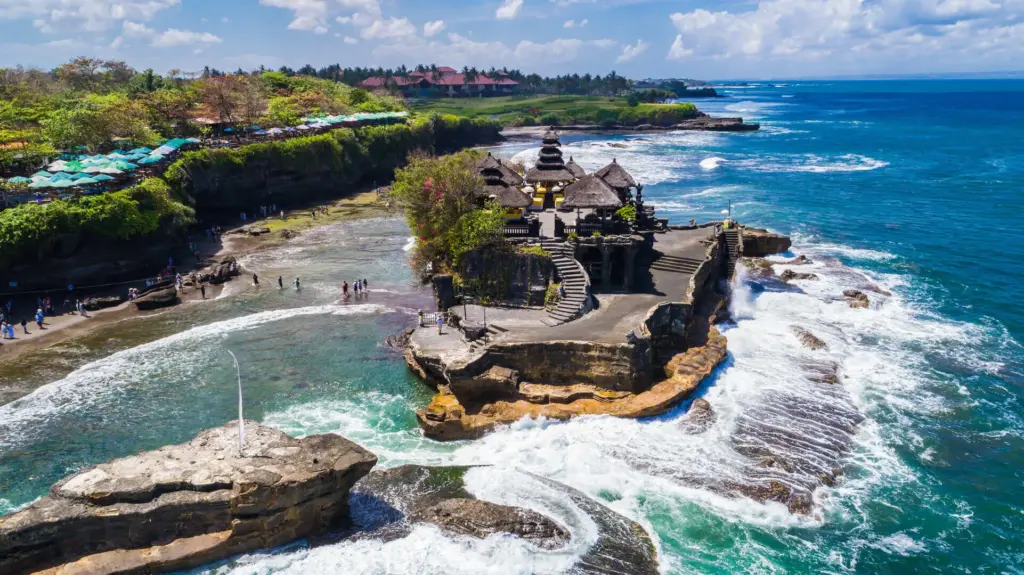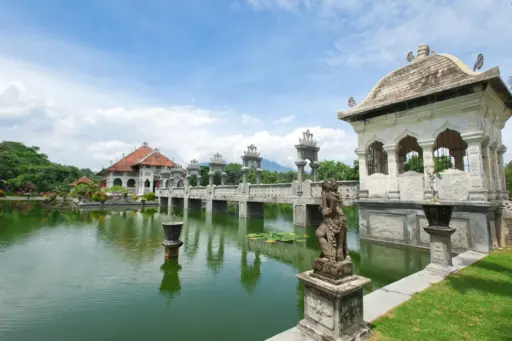Sea temple perched on Bali’s west coast, known for epic sunsets, sacred spring, and spiritual power.
Rising from a rocky outcrop just off the southwest coast of Bali, Tanah Lot is one of the island’s most photographed and spiritually revered temples. With waves crashing at its base and the Indian Ocean stretching out to the horizon, it is easy to see why this sea temple captures the imagination of travellers, photographers and worshippers alike. As the sun drops into the water behind it, the silhouette of Tanah Lot becomes a timeless image – at once dramatic, peaceful, and undeniably Balinese.
Located in the village of Beraban, in Tabanan Regency, Tanah Lot is about a 45-minute drive from Seminyak or Canggu, depending on traffic. The road to the temple winds through rice fields and quiet countryside before opening to a bustling complex of cafes, markets, and parking areas. From the entrance, visitors walk through a pathway lined with souvenir shops and warungs before reaching the coast, where the temple stands out against the sea like something from a storybook. There is an entrance fee of around IDR 75,000 for adults, which includes access to the viewing areas and cliff paths surrounding the temple.
Myths, Legends, and Sacred Springs
The name Tanah Lot loosely translates to “Land in the Sea,” which describes its physical setting perfectly. The temple sits atop a rock formation just metres off the shoreline. During high tide, it is completely surrounded by water, giving it a mysterious, unreachable quality. At low tide, visitors can walk across the rocky base to see the temple up close, though the inner sanctuary remains closed to non-Hindus. A freshwater spring beneath the temple is considered holy, and temple priests often allow visitors to receive a small blessing and sip from the spring.
Tanah Lot is believed to have been established in the 16th century by Dang Hyang Nirartha, a revered Javanese priest who travelled across Bali spreading Hindu teachings. According to legend, Nirartha was drawn to the site’s powerful energy and spent time meditating there. When local villagers tried to persuade him to leave, he used his spiritual powers to move a large rock into the sea and built a shrine atop it. The temple became a place to honour Dewa Baruna, the god of the sea, and it has been a site of worship and pilgrimage ever since.
Spiritual Power and Ceremonies
Spiritually, Tanah Lot is one of Bali’s seven sea temples, which were built along the island’s southwest coast to form a chain of protective shrines, each within sight of the next. Together, these temples are believed to guard the island from negative sea spirits. Tanah Lot is considered especially powerful because of its position – where land, sea and sky converge in a near-perfect triangle. It is one of the island’s pura kahyangan jagat, or directional temples, which play a central role in maintaining spiritual balance across Bali.
Despite being a major tourist attraction, Tanah Lot retains its spiritual essence. Daily offerings are made, and temple ceremonies take place regularly, particularly during the temple’s odalan (anniversary), which is held according to the 210-day Balinese Pawukon calendar. During these times, the temple is adorned with white and yellow cloths, bamboo decorations and flower offerings, and the site fills with local worshippers in ceremonial dress.
Sunset Views and Lasting Impressions
The landscape around Tanah Lot is just as memorable as the temple itself. Cliffs and rock pools stretch along the coast, and walking paths offer panoramic views of the temple and the ocean beyond. Photographers often arrive early to claim a good spot for sunset, and when the tide is low, the rocky shore becomes a place for kids to play and couples to explore hand in hand. The sunsets here are famous, and rightly so – the temple silhouetted against a flaming sky is one of Bali’s classic sights.
Visitors will find plenty of facilities nearby, including toilets, restaurants, cafes and shops selling everything from handmade crafts to cold drinks. While the main temple area can get crowded, especially in the late afternoon, it is still possible to find quieter corners along the clifftop paths or by venturing a little further down the coast. If you want to avoid crowds altogether, consider arriving early in the morning when the light is soft, the air is cool, and the tour buses have yet to arrive.
Tanah Lot is also a great spot to observe the way Bali balances tourism and tradition. While the area has been developed to accommodate visitors, the temple itself remains under the protection of the local community and religious leaders. Strict rules help preserve its sanctity – no climbing, no entering the inner shrine without permission, and respectful behaviour is expected throughout the complex. Even with cameras clicking and guides narrating stories, there is a sense that this place is still alive with meaning.
For many, Tanah Lot is a must-see, not just because of its beauty, but because it represents something essential about Bali. It is a place where nature and spirituality meet, where stories from the past still shape the present, and where the everyday rituals of Balinese life play out against one of the most spectacular backdrops imaginable. Whether you visit to pray, to take photos, or simply to pause and watch the sunset, you will feel something here – something older than the temple itself, something that lingers in the sound of the waves and the scent of incense on the sea breeze.
Though it only takes an hour or two to explore, Tanah Lot stays with you. It is the kind of place that reminds you why people fall in love with Bali – not just for the beaches or the surf, but for moments like this, when myth, landscape, and devotion come together in perfect harmony.




